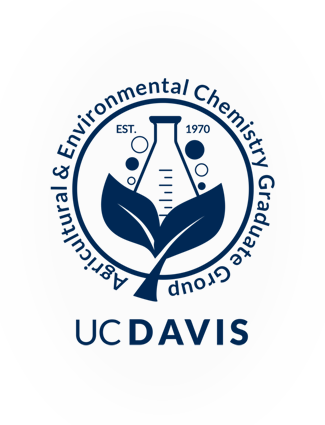Faculty Emeriti
| Name | Contact Information | Research Interests |
| Douglas Adams Professor Emeritus |
Viticulture and Enology 3150 RMI North (530) 752-1902 Website |
Dr. Adams’ research program focuses on grape berry ripening. He has concentrated his efforts in two principal areas: the biochemical changes that occur during ripening, and the development of tannins in skins and seeds of red wine varieties. |
| Diane M. Barrett Fruit and Vegetable Products Specialist |
Food Science & Technology 114 Food Sci & Tech (530) 752-4800 Website |
Fruit and vegetable quality, as affected by handling, storage, and processing conditions. Focus on thermal processing, freezing, and dehydration and the role of enzymes in fruit and vegetable flavor, color, and texture. |
| Linda F. Bisson Professor & Geneticist |
Viticulture and Enology Maynard A. Amerine Endowed Chair in Viticulture and Enology 3011 Wickson Hall (530) 752-3835 Website |
Nutrient sensing in yeast: glucose utilization, detection, signal transduction and rate of glycolytic flux. Analysis of causes of fermentation arrest in yeast. Proteome analysis of global gene expression in Saccharomyces in the natural environment. Off-character production during fermentation of grape juice. Investigation of chemical instability in wines. |
| Andrew J. Clifford Professor Emeritus |
Nutrition 3147 Meyer Hall (530) 752-3376 Website |
Dynamics of nutrient metabolism in vivo in humans. Nutrients of special interest include folic acid, vitamin A, carotenes and phytonutrients. Research involves synthesis of nutrients tagged with deuterium, carbon-14 and/or carbon-13, administering the tagged nutrients (or intrinsically labeled foods) to human volunteers and determining the metabolic fate of the nutrients. Analytic methods used include HPLC, GC, MS, MSMS, AMS, HPLC-MS and GC-MS. physiologic compartmental models (mathematical simulations) are constructed from nutrient isotopomer ratios in tissues by time since dosing to describe the dynamics of nutrient metabolism. |
| William H. Casey Professor |
Department of Chemistry 1480 Chemistry Annex (530) 752-3211 Website |
Professor Casey is interested in the reactions between water, rock and minerals. Many weathering phenomena involve reactions with water on mineral surfaces, something which can be mimicked in the laboratory by studying the aqueous chemistry of metal aquo clusters by heteronuclear NMR and MS. Other interests include crystal growth, general cluster chemistry, bio-inorganic chemistry, and chemistry from an environmental aspect. |
| Michael Denison Professor |
Environmental Toxicology 4241 Meyer Hall (530) 752-3879 Website |
Molecular mechanisms of action of halogenated aromatic hydrocarbons; Structure and function of receptors for xenobiotics and hormones; Molecular mechanisms of constitutive and inducible gene expression; Molecular approaches to development of toxicant of toxicant bioassay systems. |
| Edwin Frankel Adjunct Professor Emeritus |
Food Science and Technology 207 Food Sci & Tech (530) 752-4478 |
Lipid oxidation; food and biological antioxidants; lipid chemistry and technology; lipid peroxidation in biological systems; phytochemical antioxidants in wine, fruit, spices, and beverages; low density lipoprotein (LDL) oxidation. |
| John P. Knezovich Adjunct Professor |
Department of Environmental Toxicology 4239 Meyer HallPhone: 925-422-0925 Website |
The environmental fate and toxicity of organic contaminants, heavy metals, and radionuclides. Emphasis on the application of ion-beam analytical techniques to assess the bioavailability of contaminants and their in vivo disposition. Use of accelerator mass spectrometry to assess the fate of low-doses (i.e., environmental concentrations) of contaminants through the application of isotopic tracers. |
| Douglas M. Mackay Adjunct Professor |
Land Air and Water Resources 650-400-3998 Website |
Laboratory and field studies of transport and fate of chemical contaminants and their transformation products in the vadose and saturated zones. Groundwater remediation technologies, including field pilot testing and approaches for performance assessment. Methods for estimating total mass discharge of, and thus risk presented by, contaminants flowing in groundwater or migrating through the vadose zone. Methods for release and mixing of solutes (remediation, amendments, tracers) into groundwater. Performance and use of conservative tracers and tracers with other abilities (e.g. detecting presence of non-aqueous phase liquids, a.k.a. NAPLs). Secondary impacts of groundwater remediation. Factors limiting natural attenuation of organic contaminants in the vadose and saturated zones, including crude oil, refined petroleum products, ethanol-blended gasoline, gasoline oxygenates, pesticides, and halogenated solvents. |
| Krishnan P. Nambiar Associate Professor Emeritus |
Bio-organic Chemistry (530) 752-4757 |
Research focused on understanding the chemical interactions involved in macromolecular recognition relevant to biological systems and the utilization of the resulting information in the design of novel molecules with chemical and biological applications. |
| James R. Sanborn Associate Research Scientist |
Entomology (530) 752-8465 Fax: (530) 752-1537 |
Development of occupational and non-occupational pesticide exposure assessment for humans; synthesis of haptens for immunoassays. |
| James N. Seiber Professor Emeritus |
Environmental Toxicology Office: 4143 Meyer Hall Phone: (530)-752-1141 |
Dr. Seiber’s research interests include food chemistry, food safety, and health benefits of foods; analytical chemistry of foodborne phytonutrients and toxicans. Environmental sciences; transport and fate; agricultural and environmental chemistry; chemistry of pesticides, industrial byproducts, and naturally occurring toxicants; chemistry of plant-derived poisons; risk assessment for chemicals in the environment; trace organic analysis; new methods for disposing of chemical, agricultural, and industrial wastes; human exposure analysis; food protection; biobased products from renewable resources; environmental chemistry associated with biofuels. |
| Taka Shibamoto Professor |
Environmental Toxicology 4115 Meyer Hall (530) 752-4523 Website |
Genotoxicity study of food constituents. Chemistry and physiology of flavors and fragrance. Mutagens and carcinogens occurring during heat treatment of foods. Role of lipid perixidation in aging, carcinogenesis, and mutagenesis. Fate of pesticides in the environment. |
| Charles Shoemaker Professor Emeritus |
Food Science and Technology 127 Cruess Hall (530) 752-8079 Website |
Food rheology; interfacial phenomena in food systems; microcomputer technology in food analysis and process control. (physical chemistry) |
| Gary M. Smith Professor |
Food Science and Chemistry Director, UCD NMR Facility 112 Food Sci & Tech (530) 752-6168 Website |
Mechanisms of enzyme action, heme proteins, microbial adaptation to chill and osmotic stress, nuclear magnetic resonance, dairy chemistry. (biochemistry) |
